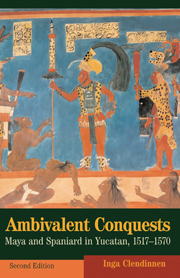Book contents
- Frontmatter
- Contents
- List of illustrations
- Preface to the second edition
- Preface to the first edition
- Acknowledgments
- Map I Yucatan in the conquest period
- Part I Spaniards
- 1 Explorers
- 2 Conquerors
- 3 Settlers
- 4 Missionaries
- 5 Conflict
- 6 Crisis
- 7 Attrition
- 8 Retrospections
- Epilogue: The hall of mirrors
- Part II Indians
- Epilogue: Confusion of tongues
- Appendix: A sampler of documents
- Glossary of Spanish and Maya terms
- Notes
- Select bibliography
- Index
2 - Conquerors
Published online by Cambridge University Press: 05 October 2013
- Frontmatter
- Contents
- List of illustrations
- Preface to the second edition
- Preface to the first edition
- Acknowledgments
- Map I Yucatan in the conquest period
- Part I Spaniards
- 1 Explorers
- 2 Conquerors
- 3 Settlers
- 4 Missionaries
- 5 Conflict
- 6 Crisis
- 7 Attrition
- 8 Retrospections
- Epilogue: The hall of mirrors
- Part II Indians
- Epilogue: Confusion of tongues
- Appendix: A sampler of documents
- Glossary of Spanish and Maya terms
- Notes
- Select bibliography
- Index
Summary
With the spoils of Mexico divided, Spanish interest had turned again to Yucatan. Late in 1526 Francisco de Montejo, who had served as a captain in both the Grijalva and the Cortés expeditions, obtained a charter from the Crown for the pacification of the peninsula. He proclaimed his proposed conquest throughout a Spain enchanted afresh by a New World which had already yielded one Mexico. Within a few months he had secured four good ships, cannon, excellent small arms, horses, and what he believed to be abundant supplies of meat, oil, wine, vinegar and biscuits. He had recruited a surgeon, two pharmacists, three churchmen – two seculars and a Carmelite – and several Catalan merchants, complete with merchandise to trade with the Indians and, when they should get established, with the conquistadores-turned-settler. Among the usual adventurers attracted to Montejo's standard were a few men of significant rank. When the smart little fleet dropped down past San Lúcar de Barrameda late in the June of 1527, it looked, as Montejo believed it to be, ‘the best that has come out from Castile’. Arrived in Hispaniola, the expedition was stiffened by the intake of some seasoned men, and horses enough to bring the cavalry up to fifty – an indication of the tough reputation the Maya warriors of the coastal towns had won for themselves. But there was one surprising lack. Montejo had known and spoken with Aguilar, and with Cortés’ more famous interpreter Doña Marina. He knew the ‘pacified’ Indians of Tabasco spoke a tongue intelligible to the Yucatan Maya.
- Type
- Chapter
- Information
- Ambivalent ConquestsMaya and Spaniard in Yucatan, 1517–1570, pp. 20 - 37Publisher: Cambridge University PressPrint publication year: 2003

